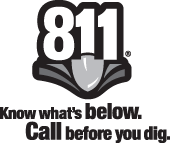Most overhead power lines are made of highly conductive aluminum with a steel core and they are NOT insulated. If you look up at a utility pole or tower, you may not be able to identify which lines are communication cables and which are energized wires. For your safety, always assume that any wire on a utility pole or tower is energized and dangerous, and stay away. All downed wires should also be considered energized and dangerous—stay far away from them as well.
Don’t be fooled by the covering on the electric service lines that go from utility poles to homes. This coating is designed to protect the line from the elements, but it is not true insulation and will not prevent injury to people. This covering will NOT protect you from electrical shock.
Keep yourself, your tools, and all equipment at least 10 feet away from overhead power lines carrying up to 50 kV. And if you are using cranes or derricks in construction, keep equipment at least 20 feet away from lines carrying up to 350 kV and 50 feet away from lines carrying greater than 350 kV. Use tape, signs, or barricades to mark a clear safety boundary. As needed, contact Xcel Energy’s Builders Call Line during business hours at 800-628-2121 to confirm the power line voltage and distance requirements.
As voltage increases, clearance distances also increase. Consult the OSHA regulations at www.osha.gov for specific safety clearance requirements or call Xcel Energy.
Additional overhead line safety tips, case studies, instructional videos, and training tools can all be found, at no charge to you, on Xcel Energy’s e–SMARTworkers website.
Do you like this email series? Do you find the information helpful? We’d like to know. Please reply to this email and tell us what you think or let us know what topics you’d like to see in future emails. |

